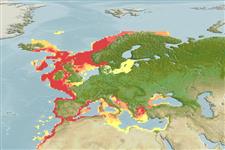Environment: milieu / climate zone / depth range / distribution range
Ökologie
seewasser bathydemersal; tiefenbereich 50 - 700 m (Ref. 56504). Deep-water; 71°N - 24°N, 19°W - 36°E
Eastern Atlantic: northern Norway to Western Sahara including southern Iceland, Faroe Islands, Shetlands and Mediterranean.
Size / Gewicht / Alter
Maturity: Lm ? range ? - ? cm
Max length : 35.0 cm SL Männchen/unbestimmt; (Ref. 35388); common length : 20.0 cm SL Männchen/unbestimmt; (Ref. 4458); max. veröff. Alter: 16 Jahre (Ref. 35388)
Relatively common on the continental shelf and upper slope, probably schools near the bottom. Depth range from 50-500 m (Ref. 35388) and from 288-700 m in the eastern Ionian Sea (Ref. 56504). Feeds on bottom-living polychaetes, mollusks and crustaceans, also on pelagic invertebrates and fishes. Spawns from winter to spring in the Mediterranean and from March to July off the British coasts. Its eggs and larvae are pelagic (Ref. 4773). They become sexually mature at a length of 12-13cm. With a smell like cucumber (Ref. 35388).
Life cycle and mating behavior
Geschlechtsreife | Fortpflanzung | Ablaichen | Eier | Fecundity | Larven
Cohen, D.M., 1990. Argentinidae. p. 235-238. In J.C. Quero, J.C. Hureau, C. Karrer, A. Post and L. Saldanha (eds.) Check-list of the fishes of the eastern tropical Atlantic (CLOFETA). JNICT, Lisbon; SEI, Paris; and UNESCO, Paris. Vol. 1. (Ref. 4458)
IUCN Rote Liste Status (Ref. 130435)
Bedrohung für Menschen
Harmless
Nutzung durch Menschen
Fischereien: weniger kommerziell
Mehr Information
ReferenzenAquakulturAquakultur ProfilZuchtlinienGenetikElectrophoresesVererbbarkeitKrankheitenVerarbeitungNutrientsMass conversion
Tools
Zusatzinformationen
Download XML
Internet Quellen
Estimates based on models
Preferred temperature (Ref.
123201): 6.4 - 13.3, mean 8 °C (based on 277 cells).
Phylogenetic diversity index (Ref.
82804): PD
50 = 0.5001 [Uniqueness, from 0.5 = low to 2.0 = high].
Bayesian length-weight: a=0.00363 (0.00281 - 0.00470), b=3.18 (3.11 - 3.25), in cm total length, based on LWR estimates for this species (Ref.
93245).
Trophic level (Ref.
69278): 3.5 ±0.5 se; based on diet studies.
Generation time: 4.0 ( na - na) years. Estimated as median ln(3)/K based on 1
growth studies.
Widerstandsfähigkeit (Ref.
120179): mittel, Verdopplung der Population dauert 1,4 - 4,4 Jahre. (tmax=7; K=0.27).
Fishing Vulnerability (Ref.
59153): Moderate vulnerability (36 of 100).
Climate Vulnerability (Ref.
125649): Low vulnerability (7 of 100).
Nutrients (Ref.
124155): Calcium = 33.5 [18.5, 90.9] mg/100g; Iron = 0.482 [0.170, 1.228] mg/100g; Protein = 14.8 [12.5, 16.8] %; Omega3 = 0.403 [0.166, 1.092] g/100g; Selenium = 19.8 [8.1, 44.9] μg/100g; VitaminA = 11.6 [2.5, 50.9] μg/100g; Zinc = 0.456 [0.300, 0.710] mg/100g (wet weight);
